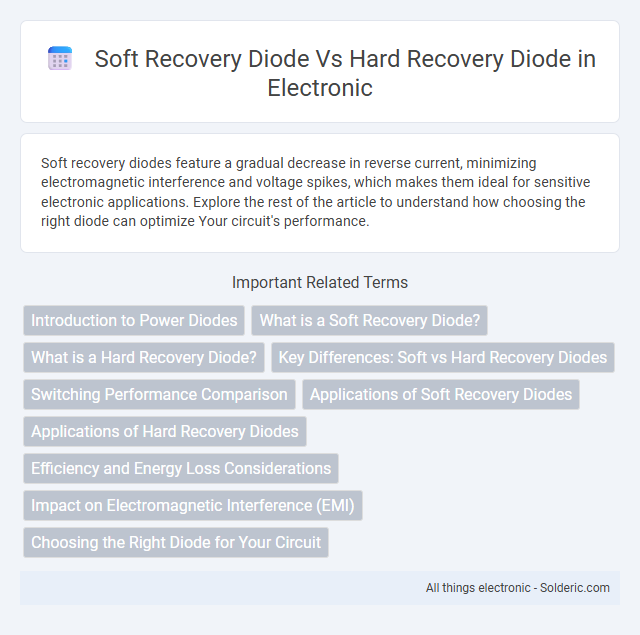Soft recovery diodes feature a gradual decrease in reverse current, minimizing electromagnetic interference and voltage spikes, which makes them ideal for sensitive electronic applications. Explore the rest of the article to understand how choosing the right diode can optimize Your circuit's performance.
Comparison Table
| Feature | Soft Recovery Diode | Hard Recovery Diode |
|---|---|---|
| Recovery Behavior | Gradual recovery with controlled reverse current decay | Rapid recovery with abrupt reverse current change |
| Switching Speed | Moderate switching speed | High switching speed |
| EMI and Noise | Low electromagnetic interference and reduced noise | High EMI and noise generation |
| Applications | Power supplies, inverters, and circuits needing low switching noise | High-speed switching applications and hard switching circuits |
| Losses | Lower switching losses due to smooth recovery | Higher switching losses from abrupt recovery |
| Typical Materials | Silicon with tailored doping profiles | Standard silicon PN junctions |
| Cost | Generally higher due to complex design | Lower cost and simpler construction |
Introduction to Power Diodes
Power diodes play a crucial role in electrical circuits by allowing current to flow in one direction while blocking reverse current. Soft recovery diodes feature a gradual decrease in reverse current, minimizing voltage spikes and electromagnetic interference, which enhances efficiency in switching applications. In contrast, hard recovery diodes exhibit a rapid cessation of current flow, leading to higher switching losses and increased stress on circuit components.
What is a Soft Recovery Diode?
A soft recovery diode is designed to reduce the voltage spike and electromagnetic interference during switching by gently transitioning from conducting to blocking state. It features a controlled reverse recovery process with lower di/dt and reduced switching losses compared to hard recovery diodes. Your power electronics circuits benefit from enhanced efficiency and reduced stress on components when using soft recovery diodes.
What is a Hard Recovery Diode?
A hard recovery diode is a type of diode characterized by its abrupt transition from the conducting to the blocking state, resulting in significant reverse recovery current and voltage spikes. It typically exhibits a high reverse recovery charge (Qrr) and sharp reverse recovery time, which can cause electromagnetic interference (EMI) and increased switching losses in power electronic circuits. Hard recovery diodes are often used in applications demanding robustness and simplicity, despite their lower efficiency compared to soft recovery diodes.
Key Differences: Soft vs Hard Recovery Diodes
Soft recovery diodes feature a gradual decrease in reverse current, minimizing voltage spikes and electromagnetic interference during switching, which makes them ideal for reducing switching losses in applications like power supplies. Hard recovery diodes exhibit a rapid reverse current drop, causing higher voltage overshoot and noise but providing faster switching speeds, often preferred in circuits where switching speed is critical despite increased stress on components. The key difference lies in the recovery time and current decay behavior, affecting efficiency, thermal management, and electromagnetic compatibility in electronic systems.
Switching Performance Comparison
Soft recovery diodes exhibit lower reverse recovery current and reduced voltage spikes during switching, resulting in improved efficiency and minimal electromagnetic interference compared to hard recovery diodes. Hard recovery diodes generate higher switching losses due to abrupt current changes and longer recovery times, causing increased stress on your power electronics. Choosing soft recovery diodes enhances switching performance by providing smoother transitions and better thermal management in high-frequency applications.
Applications of Soft Recovery Diodes
Soft recovery diodes are widely used in applications requiring reduced electromagnetic interference (EMI) and lower switching losses, such as in power supplies, motor drives, and renewable energy inverters. Their controlled and gradual recovery characteristic helps improve efficiency and reliability in high-frequency switching circuits. Your choice of soft recovery diodes can significantly enhance performance in sensitive electronics by minimizing voltage spikes and noise during diode turn-off.
Applications of Hard Recovery Diodes
Hard recovery diodes are ideal for applications requiring fast switching and high voltage handling, such as in power rectifiers, inverters, and motor drives where rapid turn-off is critical to prevent damage. These diodes excel in environments with high current surges and inductive loads, making them essential in industrial power supplies and switching power electronics. Your system benefits from hard recovery diodes in scenarios demanding robust performance and minimal recovery time to enhance overall efficiency and reliability.
Efficiency and Energy Loss Considerations
Soft recovery diodes minimize energy loss by reducing voltage spikes and current oscillations during switching, improving overall circuit efficiency in high-frequency applications. Hard recovery diodes exhibit higher recovery currents, leading to increased power dissipation and reduced efficiency, especially in fast switching environments. Choosing the appropriate diode type directly impacts your system's energy efficiency and thermal management requirements.
Impact on Electromagnetic Interference (EMI)
Soft recovery diodes generate significantly lower electromagnetic interference (EMI) compared to hard recovery diodes due to their smoother reverse recovery waveform, which reduces voltage and current spikes. Hard recovery diodes cause abrupt changes in current during switching, leading to high-frequency noise and greater EMI emissions. Employing soft recovery diodes in power electronics minimizes EMI challenges, improving system reliability and compliance with electromagnetic compatibility (EMC) standards.
Choosing the Right Diode for Your Circuit
Soft recovery diodes minimize voltage spikes and electromagnetic interference with a controlled reverse recovery process, making them ideal for sensitive or high-frequency circuits. Hard recovery diodes exhibit faster switching but generate higher noise and stress in the circuit, suitable for robust power applications where efficiency is prioritized over noise reduction. Choosing the right diode for your circuit depends on balancing the need for reduced electrical noise and switching speed to optimize performance and reliability.
Soft recovery diode vs hard recovery diode Infographic

 solderic.com
solderic.com